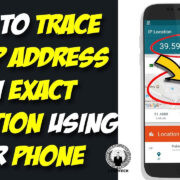In today’s world, communication has evolved well beyond face-to-face interactions, with text messages forming an essential part of our daily exchanges. They can be fun and convenient but sometimes puzzling—especially when they come from an unknown sender. You may receive messages that are mysterious, or perhaps even concerning, and naturally want to know more about the sender. Tracing a text message isn’t always straightforward, given the privacy laws and technological barriers, but there are methods that can help shed light on the origins of these digital notes.

Ask Your Service Provider
Your mobile service provider has access to data pertaining to your incoming and outgoing text messages. While they won’t usually divulge the personal details of the sender without a valid reason, they may assist you if you feel harassed or threatened.
Detailed Introduction
Reaching out to your service provider can be a helpful first step when trying to trace the origin of a text message. Providers often log the communication records, which could contain information about the sender’s phone number and the time the message was sent. However, due to strict privacy policies and regulations, they may require a formal complaint or even a law enforcement request to release this information.
Detailed Steps
- Contact your mobile service provider through their customer service hotline, website or physical store.
- Request assistance with tracing a text message, providing specifics about why you need this information.
- If your reason is deemed valid, follow their protocol, which may include filing a formal complaint.
- They may offer to block the number if it’s sending harassing messages, even if they can’t give you the details.
- If necessary, they might instruct you to get a law enforcement agency involved.
Summary
Contacting a service provider can offer a straightforward way to trace a text message if there are legitimate concerns such as harassment. The benefit includes leveraging the provider’s resources to assist you within the bounds of the law. The downside is that your request might be denied if it does not meet the severity criteria, and privacy laws limit the amount of information they can give.
Check the Message Details
Most phones have the option to view more details about received text messages, such as the sending number and the time the message was sent. Checking these details can occasionally provide clues as to who sent the message.
Detailed Introduction
Examining the header details embedded in the message can give you basic information about the sender. This does not reveal personal details but can help you identify if the message was sent from a known contact who might have simply used a different number.
Detailed Steps
- Open the text message in question.
- Tap on the sender’s information at the top of the screen, or select “Details” from the menu.
- Note down the sending number, the time, and date stamp from the message details.
- Use this information to cross-reference with your contacts or input into a further search tool.
Summary
This method is a simple and immediate way to gain the most accessible information about a text message sender. The benefit is that you can quickly get basic information such as the number and time stamp. However, it provides limited insights and no personal identification for unknown numbers.
Use a Reverse Phone Lookup Service
A reverse phone lookup service allows you to input a phone number to find available public information associated with it. Various online services offer this feature, which can sometimes include the owner’s name and address.
Detailed Introduction
Reverse phone lookup services can be a valuable tool when you’re trying to uncover the identity behind a text message. These services search through public records and databases to provide any available information related to the number. Keep in mind that the success of this method largely depends on the availability and accuracy of the data collected by the service.
Detailed Steps
- Choose a reputable reverse phone lookup service online. Some popular options include Whitepages, Spokeo, or BeenVerified.
- Enter the phone number you wish to look up in the search bar.
- Submit the search to receive a report on the number.
- Review the information provided, which may include the name, address, or other public records associated with the number.
- Some services may require payment to access full details.
Summary
Reverse phone lookup services can offer substantial information about a phone number including potentially the owner’s name. The upside is that they can be convenient and informative. However, they often come with a fee, and information may not be available for all numbers, especially if the sender is using a prepaid or unlisted number.
Utilize Social Media
Many social media platforms have a search function where you can input a phone number to find profiles associated with it. This method relies on the person having linked their phone number to their social media accounts.
Detailed Introduction
Social media platforms like Facebook, LinkedIn, and Instagram can sometimes be used to trace a phone number. Users often link their phone numbers to their profiles for account recovery or other purposes, which can be advantageous when you’re trying to identify an unknown sender.
Detailed Steps
- Go to the search bar of the social media platform of your choice.
- Type in the phone number you wish to search for.
- Look through the search results to see if any profiles are associated with that number.
- Check those profiles for potential identification of the sender.
Summary
This method benefits from being free and straightforward, using platforms that many are already familiar with. However, its success hinges on whether the individual has their number linked to a visible profile, and privacy settings often limit the information available.
Google the Number
Sometimes a simple Google search can yield surprising results. Since phone numbers are occasionally listed on public websites or forums, you might find information about the sender through this method.
Detailed Introduction
Search engines like Google index vast amounts of information from the web, which can include contact details listed on company websites, personal blogs, forums, or classified ads. Simply searching for the phone number might direct you to a page where it’s listed along with other identifying information.
Detailed Steps
- Open Google or any other search engine.
- Type the full phone number, including the area code, into the search bar.
- Browse through the search results for any webpages that list the number.
- Look for any context around the number that might indicate who owns it or why it might be contacting you.
Summary
The main advantage of this method is its cost (free) and ease of use. However, it may return an overwhelming number of unrelated results, and there’s no guarantee that the number will be listed publicly anywhere.
Check for Apps or Spam Blockers
Various apps are designed to identify incoming calls and text messages, tagging spam or providing identification for known numbers based on a crowd-sourced database.
Detailed Introduction
Apps like Truecaller or Hiya collect data from a vast number of users to build a database of phone numbers and associated names or businesses. This can be useful for determining if a number is known for spam or has been labeled by others with a certain name.
Detailed Steps
- Download a caller identification app from your phone’s app store.
- Register and set up the app according to the instructions.
- Use the app’s search function to input the unknown number.
- View the information provided by the app, which might include a name, business, or spam rating.
Summary
The benefit of these apps is their user-friendly nature and the collective intelligence they provide. However, these apps may not have information on all numbers, and there’s sometimes a fee for full access to the database. There are also privacy concerns to consider when sharing your own contact list with these services.
Inbox Message Analysis
Analyzing the content of the message itself can sometimes give you clues as to who sent it or for what purpose.
Detailed Introduction
The message may contain hints such as names, specific references, or language that can help you deduce its origin. This requires a bit of detective work and an understanding of the context.
Detailed Steps
- Read the message carefully, noting any peculiar phrases, names, or references.
- Consider any recent interactions you’ve had that might relate to the text.
- Compare the writing style to known contacts if the message seems familiar.
- Analyze the purpose of the message. If it seems promotional or generic, it might be spam or a mass text.
Summary
This technique has the advantage of being absolutely free and draws on your own insights and intuition. However, it can be unreliable and is entirely subjective, plus it cannot provide a definitive answer on its own.
Involve Law Enforcement
If you believe the text message has questionable or illegal content, or if you feel threatened, involving law enforcement can be a necessary step.
Detailed Introduction
Official authorities have the means to perform a more comprehensive investigation into the origins of a text message. But they will typically only do this in the face of harassment, threats, or illegal activity.
Detailed Steps
- Keep a record of all communications you’ve received from the number.
- Report the incident to your local police department providing as many details as possible.
- Cooperate with the authorities as they conduct their investigation.
Summary
Law enforcement can provide the most definitive results through their investigation methods. This option, however, is only viable in serious circumstances and involves a more complex and longer process.
Create a Contact and Wait
Adding the number to your contact list and waiting for a profile picture or status update can provide clues, assuming the number is registered with a messaging service like WhatsApp.
Detailed Introduction
Many messaging apps display a profile picture, status, or ‘about’ information for contacts in your phone. By saving the number and checking these platforms, you may find out who the number belongs to if they have shared such information.
Detailed Steps
- Save the unknown number as a contact in your phone.
- Open messaging apps like WhatsApp that show profile information.
- Look for an image or status associated with that contact, which may help identify them.
Summary
This is a passive and privacy-respecting method which might offer identification clues. However, its success is conditional on the sender having shared a profile picture or status, and many people keep this information private.
Informal Inquiry
Consider asking family, friends, or colleagues if they recognize the number or have received similar messages, as the sender may be someone within your social or professional network.
Detailed Introduction
Sometimes the simplest solutions can yield results. A message might have been sent by someone you know or by someone within your wider social or professional circles.
Detailed Steps
- Write down or remember the suspect number.
- Casually inquire with your contacts to see if the number is familiar to them.
- Expand this informal inquiry to include social media posts if appropriate, asking if anyone recognizes the number.
Summary
This method relies on your social network and can be a very discreet way of finding out information about the sender. Yet, it might not yield any results, and there’s also a risk of spreading information if the text was meant to be private.
In conclusion, tracing the origins of an unknown text message can be both important and challenging. While the methods above vary in terms of ease, cost, and legal considerations, they each provide a different approach to solving this modern mystery. Combining several methods may increase your chances of success, but it’s critical to respect privacy laws and consider the ethical implications of your search. With technology advancing every day, the tools at our disposal for identifying unknown communications are ever-improving, making it increasingly likely that the source of a text message can be unmasked.
FAQ
-
Is it legal to trace a text message sender?
Yes, it is legal to trace a text message sender if you are doing so for your personal safety or peace of mind. However, using this information to harass someone or violate their privacy is illegal. -
What should I do if I receive threatening text messages?
If you receive threatening text messages, you should save the messages, refrain from responding, and report the issue to law enforcement as soon as possible. -
Can I find out who sent a text message if the number is not listed or is a prepaid number?
It can be more difficult to trace a text message from an unlisted or prepaid number as these may not be included in public directories or have readily available information linked to them. However, using some of the methods above, such as involving law enforcement, may yield results in serious cases.









